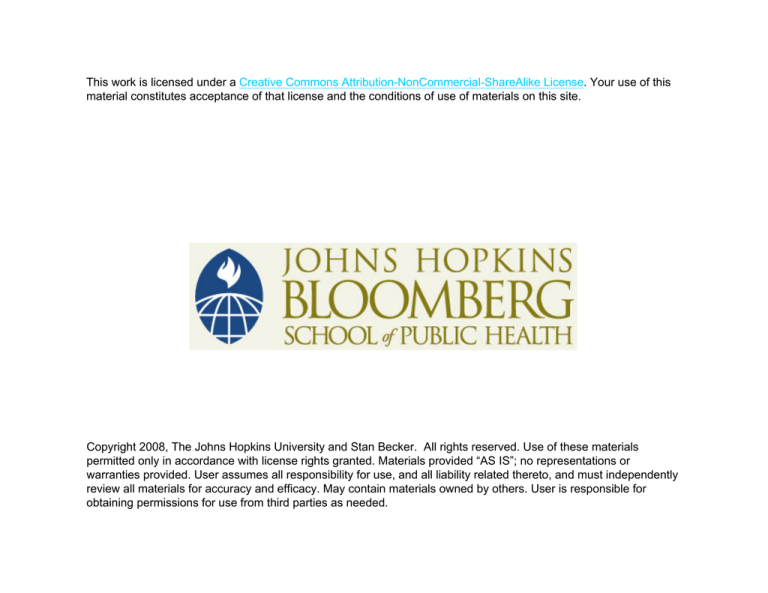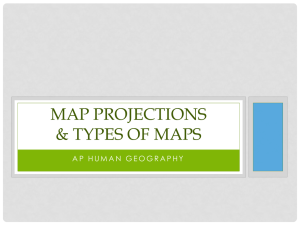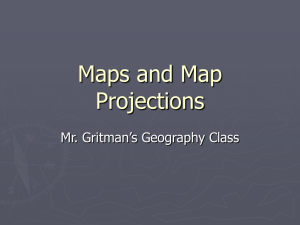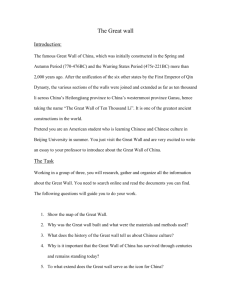
This work is licensed under a Creative Commons Attribution-NonCommercial-ShareAlike License. Your use of this
material constitutes acceptance of that license and the conditions of use of materials on this site.
Copyright 2008, The Johns Hopkins University and Stan Becker. All rights reserved. Use of these materials
permitted only in accordance with license rights granted. Materials provided “AS IS”; no representations or
warranties provided. User assumes all responsibility for use, and all liability related thereto, and must independently
review all materials for accuracy and efficacy. May contain materials owned by others. User is responsible for
obtaining permissions for use from third parties as needed.
Population Change and
Projection
Stan Becker, PhD
Bloomberg School of Public Health
Section A
Rate of Change, Doubling Time, and
the Relationship between Age
Distinction and Demographic Rates
Population Change
Book-keeping equation
Let Pt = Population at time “t”
P0 = Population at an earlier time “0”
B = Births between time “0” and time
“t”
D = Deaths between time “0” and “t”
I = In-migration / immigration
between time “0” and “t”
O = Out-migration / emigration
between time “0” and “t” Continued
4
Population Change
The population changes by adding births
and in-migrants and subtracting deaths and
out-migrants
Pt = P0 + B − D + I − O
Let b = Number added per time unit
Pt − P0
b=
t
5
Linear Change
The population size changes by exactly the
same amount “b” during each time period
“t”
Pt = P0 + bt
6
Linear Annual Rate of Change
Beginning of Period Approximation
ri = linear annual rate of change
(beginning of period approximation)
Pt − P0
ri =
tP0
Pt = P0 + ri ∗ t ∗ P0
7
Linear Annual Rate of Change
Arithmetic or Mid-Point Approximation
rm = linear annual rate of change
(arithmetic or mid-point approximation)
Pt − P0
b
=
rm =
1/ 2(Po + Pt ) t / 2(Po + Pt )
8
Exercise
Linear Annual Growth Rate
The Mexican population was estimated at
77,938,288 at the 1985 census and at
91,158,290 at the 1995 census
Calculate the linear annual growth rate
using both types of approximations
You have 15 seconds to calculate the answer. You
may pause the presentation if you need more time.
Source: U.N. Demographic Yearbook, 1992 and 1997
9
Exercise Answer
Linear Annual Growth Rate
The correct answers are as follows:
ri
rm
1.70%
1.56%
10
Problem with the LinearChange Approach
Adding a fixed amount in each time period
⇒ the rate of change decreases because
b / Pt -> 0
Say b = P0
Then P1 = P0 + P0 = 2P0
P2 = P1 + P0= 3P0
Continued
11
Problem with the LinearChange Approach
So
P1 − P0
r1 =
=1
1∗ P0
rm1
P1 − P0
=
1 2(P0 + P1)
P0
2
=
=
3 2 P0 3
Continued
12
Problem with the LinearChange Approach
And each continues declining
P2 − P1
r2 =
1∗ P1
3P0 − 2P0 1
=
=
2P0
2
rm2
P2 − P1
=
1 2(P1 + P2 )
P0
2
=
=
5 2 P0 5
13
Geometric Change
The population changes by step, i.e., the
increment added (or the decrement is
subtracted) periodically
Pt = P0 (1 + rg )
t
Where rg = geometric rate of growth
14
Geometric Annual Rate
of Change
rg =
t
Pt
−1 = e
P0
1 ⎛ Pt ⎞
ln⎜⎜ ⎟⎟
t ⎝ P0 ⎠
− 1
15
Exercise
Geometric Annual Rate of Change
The Mexican population was estimated at
77,938,288 at the 1985 census and at
91,158,290 at the 1995 census
Calculate the geometric annual growth rate
You have 15 seconds to calculate the answer. You
may pause the presentation if you need more time.
Source: U.N. Demographic Yearbook, 1992 and 1997
16
Exercise Answer
Geometric Annual Rate of Change
The correct answer for rg is as follows:
– 1.58%
17
Exponential Change
The population changes instantaneously
and continuously
Pt = P0 e
rt
18
Exponential Growth Rate
Exponential growth rate
1 ⎛ Pt ⎞
r = ln ⎜⎜ ⎟⎟
t ⎝ P0 ⎠
The advantage of the exponential method is that
it’s easy to solve for any parameter
⎛ Pt ⎞
ln ⎜⎜ ⎟⎟
P0 ⎠
⎝
t=
r
Pt
P0 = rt
e
19
Exercise
Exponential Growth Rate
The Mexican population was estimated at
77,938,288 at the 1985 census and at
91,158,290 at the 1995 census
Calculate the exponential growth rate
You have 15 seconds to calculate the answer. You
may pause the presentation if you need more time.
Source: U.N. Demographic Yearbook, 1992 and 1997
20
Exercise Answer
Exponential Growth Rate
The correct answer for “r” is as follows:
– 1.57%
21
Relation Between Rates of Change
Geometric and Exponential
r
rg = e − 1
2
3
x
x
since e = 1 + x +
+
+ ...
2!
3!
x
2
r
then rg = r +
+ ...
2!
⇒ rg > r
22
Rate of Natural Increase
Let B
D
P
b
d
=
=
=
=
=
Births during a calendar year
Deaths during same year
Midyear population
Birth rate
Death rate
Continued
23
Rate of Natural Increase
Most direct indication of how rapidly a
population actually grew as the result of
vital processes
B −D
r=
∗ 1000
P
=b-d
r < 0 ⇒ D>B
r = 0 ⇒ B =D
r >0 ⇒ B >D
Is influenced by age structure
24
Doubling Time
Calculation based on exponential growth
(“r” fixed in time)
Allows determination of how long it will
take a population to double in size (i.e.,
time for Pt / P0 = 2)
Continued
25
Doubling Time
Since
⎛ Pt ⎞
ln ⎜⎜ ⎟⎟
P0 ⎠
⎝
t=
r
Then for doubling time
ln( 2)
t=
r
Continued
26
Doubling Time
Approximation
70
t=
r ∗ 100
27
Some Examples of
Doubling Times
Rate of Number of Rate of Number of
Growth
Years
Growth
Years
1.0
69.3
2.0
34.7
1.1
63.0
2.1
33.0
1.2
57.8
2.5
27.7
1.3
53.3
3.0
23.1
1.4
49.5
3.5
19.8
1.5
46.2
4.0
17.3
28
Number of Years
Number of Years Necessary for the Population to
Double at Given Fixed Annual Rates of Growth
140
90
40
-10
0.0 0.5 1.0 1.5 2.0 2.5 3.0 3.5 4.0
Rate of Growth
29
Exercise
Doubling and Tripling Time
The Mexican population was estimated at
77,938,288 at the 1985 census and at
91,158,290 at the 1995 census
Assuming Mexico's population is growing
exponentially, what is its doubling time?
In what year will the mid-1975 population
have tripled?
You have 15 seconds to calculate the answer. You
may pause the presentation if you need more time.
Source: U.N. Demographic Yearbook, 1992 and 1997
30
Exercise Answer
Doubling and Tripling Time
The correct answers are as follows:
– Doubling time = 44.2 years
– Tripling time = 70.1 years
– Year will triple = 2045
31
The Relationship between Age
Distribution and Demographic Rates
Age distribution of a population gives a
record of the demographic history of that
population
Continued
32
The Relationship between Age
Distribution and Demographic Rates
Age distribution is sensitive to changes in
demographic rates, particularly fertility and,
for small areas, migration rates
In a closed population (i.e., no migration)
the age distribution is determined only by
fertility and mortality
33
Summary
Population change is measured by the
difference between population sizes at
different dates
As time goes by, the population in an area
can do the following:
– Grow by adding births or people moving
in the area (in-migrants)
– Or it can decrease because of deaths or
people moving out of the area (outmigrants)
Continued
34
Summary
The simplest method to estimate the
population at a later time from that of an
earlier date is the bookkeeping method,
which adds the births and in-migrants to
the initial population and subtracts the
deaths and out-migrants
Continued
35
Summary
Mathematical models have been developed
to estimate the average annual rate of
change based on different assumptions on
the way the population has grown during
the period
36
Section B
Projection
Population Projection
Population Projection—Forecast of
population change using estimates of
fertility, mortality, and migration
Projections may extend for varying
numbers of years into the future
Note:
– Extrapolation = projection
– Interpolation = estimation
Continued
38
Population Projection
Long-term projections (over 25 years) are
used in connection with the development
of natural resources, planning for provision
of food, for transportation and recreational
facilities, etc.
Middle-range projections (10–25 years) are
used for planning educational and medical
facilities and services, housing needs,
etc.
39
Component Method
Has become the standard methodology for
projection
Makes explicit the assumptions regarding
the components of population growth—
mortality, fertility, and net migration
Gives insight into the way population
changes
Continued
40
Component Method
Allows the user to estimate the effect of
alternative levels of fertility, mortality, or
migration on population growth
Used to obtain projections of age-sex
structure
41
General Principles
Start with the population distributed by age
and sex at base date
Apply assumed survival rates and age-sex
specific fertility rates to obtain number of
persons alive at the end of a unit of time
Continued
42
General Principles
Make allowance for net migration by age
and sex, if desired
Generally five-year age groups are used
Projection interval must be integer multiple
of age interval
43
Population Projection
Projection assuming closed population, constant fertility,
and constant mortality
– Let x = Age 5, 10, …, w
t = Time “t”
5Lx = Life table number of persons
between ages “x” and “x+5” at time
“t”
5L x
= Survival ratio from age group
(x-5, x) to age group (x, x+5)
5 L x −5
Continued
44
Population Projection
P
t+5
x , x +5
= P
t
x −5 , x
Lx
∗
5 L x −5
5
Projection of the population aged 55 to 59
from 1990 to 1995
P
1995
60 − 64
= P
1990
55 − 59
L
∗
5L
5
60
55
45
Treatment of Open-Ended
Interval
P t +5
w+
T
L
(w +5)
t
5 w
t
=P ∗
+P ∗
w −5
w+
L
Tw
5 w −5
Where w+ refers to the oldest age group
Continued
46
Treatment of Open-Ended
Interval
Keyfitz’s method
t +5
85 +
P
=5 P
t
80
T90
L 85
t
∗
+ P85 + ∗
T85
5 L 80
5
– In stationary population
P80
5 L 80
=
⇒ P85 + =
T 85
P85 +
5
5
P80 ∗ T 85
5 L 80
Continued
47
Treatment of Open-Ended
Interval
– Substituting
P
t +5
85 +
=5 P
t
80
⎛ 5 L 85
T 85
T 90
∗ ⎜⎜
+
∗
T 85
5 L 80
⎝ 5 L 80
= 5 P80
=
5
⎛ 5 L 85 + T90
∗ ⎜⎜
5 L 80
⎝
P 80
⎞
⎟⎟
⎠
⎞
⎟⎟
⎠
T 85
∗
5 L 80
48
Getting P0-4 at Time t+5
Let 5Lx = Number of survivors between
ages “x” and “x+5”
f = Female fertility rate for age
F
5 x
group (x, x+5)
x = Age “x”
Continued
49
Getting P0-4 at Time t+5
Also let α = Beginning age of reproduction
β = End of reproductive age
5Fx = Female fertility rate for age
group x, x+5
Continued
50
Getting P0-4 at Time t+5
t + 5 = Survivors to time “t+5” of births
that occurred between “t” and
5 P0
“t+5”
β −5
⎡
⎤
⎛
⎞
L
L
f
f
= 5 0 ∗ ⎢ ∑ ⎜⎜ 5 Fx + 5 x + 5 ∗5 Fx + 5 ⎟⎟ ∗5 Px ⎥
2l 0 ⎣ x = α −5 ⎝
5L x
⎠
⎦
51
Getting P0-4 at Time t+5 Derivation
Births in one year =
⎛
(1/2 ) ∗ ⎜⎜ 5 P15 +
⎝
L 15
∗ 5 P10
5 L 10
5
⎛
... + (1/2 ) ∗ ⎜⎜ 5 P 40 +
⎝
= (1/2
β −5
)∗ ∑
x = α −5
⎛
⎜⎜ 5 F x +
⎝
⎞
⎟⎟ ∗ 5 F 15 +
⎠
L 40
∗ 5 P35
5 L 35
⎞
⎟⎟ ∗ 5 F 40
⎠
L x +5
∗
5L x
⎞
⎟⎟ ∗ 5 P x
⎠
5
5
5
Fx +5
Continued
52
Getting P0-4 at Time t+5 Derivation
Births in five years =
β −5
⎡
⎤
⎛
⎞
5 L x +5
5 ∗ ⎢ (1/2 ) ∗ ∑ ⎜⎜ 5 Fx +
∗ 5 Fx + 5 ⎟⎟ ∗ 5 Px ⎥
x = α −5 ⎝
5L x
⎠
⎣
⎦
53
Population Projection
To get P0-4, births must survive an average
of 2.5 years
5
P
t+5
0
⎤
⎞
5 5 L 0 ⎡ β −5 ⎛
5L x +5
= ∗
∗ ⎢ ∑ ⎜⎜ 5 Fx +
∗ 5 Fx + 5 ⎟⎟ ∗ 5 P x ⎥
2 5l 0 ⎣x =α−5 ⎝
5L x
⎠
⎦
L0
=
2l 0
5
5 L
=
2l
0
0
⎡ β −5 ⎛
∗ ⎢ ∑ ⎜⎜ 5 F x +
⎣x =α−5 ⎝
⎡
∗ ⎢
⎣
β − 5
∑
x = α − 5
⎛
⎜⎜
⎝
5
Px +
5
L
5
5
L
5
x+5
L
x
x + 5
L
∗5 Fx + 5
x
∗5 Px
⎤
⎞
⎟⎟ ∗ 5 P x ⎥
⎠
⎦
+ 5
⎤
⎞
⎟⎟ ∗ 5 F x ⎥
⎠
⎦
54
Matrix Representation
1st row represents fertility rates and 0–5
survival
Sub-diagonal represents survival ratios
from one age group to another
Note: The rest of the matrix (L) has zeros
Continued
55
Matrix Representation
⎤
⎡
⎥
⎢
⎛
⎞
⎛
⎞
L0 L15
L
L
⎥
⎢0 0
⎜⎜ ∗F15⎟⎟ 0 ⎜⎜F15 + 20 ∗F20⎟⎟ ... 0
0
⎥
⎢
2l0 ⎝L10 ⎠ 2l0 ⎝
L15
⎠
⎥
⎢
⎢L5 0
0
0
... 0
0⎥
⎥
⎢L0
⎥
⎢
L10
L = ⎢0
0
0
... 0
0⎥
⎥
⎢
L5
⎥
⎢
.
.
.
.⎥
⎢.
⎢.
.
.
.
.⎥
⎥
⎢
.
.
.
.⎥
⎢.
⎥
⎢
L
T
⎢0 0
0
0
... w-5 w ⎥
Lw-10 Tw-5 ⎥⎦
⎢⎣
56
Population Projection
To get the population at a later date
t
t +5
L ∗P = P
L ∗P
t+5
= P
t + 10
2
= L ∗P
t
etc.
Continued
57
Population Projection
To project the total population at a later
date
– First, use the female projection and
fertility rates for both boy and girl births
– Then, put the male births into male
projection
– Note: The male matrix only contains
survival ratios
58
Projection Adjusting for Net
Migration (NM)
P
t +5
t
= L ∗ P + NM
Where NM = Net migration
It is easiest to take net migration into
account at the end of each time interval
Getting estimates of net migration by age
and sex, and projected numbers by age
and sex, may be difficult
59
Projection Adjusting for Changes
in Fertility and Mortality
Let Li = Projection matrix for ith interval
L0 = Projection matrix for first interval
60
Population Projection
Ex: At time t+10
t +10
P
1
(
0
t
= L ∗ L ∗P
)
Or more generally
t +5∗n
P
n−1
=L
n−2
0
t
∗L ...∗ L ∗P
Where Li = Projection matrix for ith time
interval
Continued
61
Population Projection
Note: Stable population results from
unchanging rates of births and deaths
Since Ln “stabilizes” when “n” gets large
(i.e., for every element), its value in “Ln+1”
divided by its value in “Ln” converges to a
constant “λ”
Continued
62
Population Projection
Therefore:
n+1
t
n
t
L ∗P = λ ∗L ∗P
t
t +5
so λ ∗ P = P , and
t +5
P
5r
λ = t = e in continuous notation
P
Continued
63
Population Projection
Several variations of projection exist for
changing rates
– Change fertility rates by x% and/or
mortality rates by y%, at each step
– Fix final levels of fertility and mortality
and interpolate between the two time
periods
– Note: Net migration can also be easily
made to vary
64
Projection for Small Areas
Internal migration (e.g., rural-urban
migration) may be important
Population projection for political units with
relatively few boundary changes (e.g.,
states) and for statistical subdivisions with
boundaries changing (e.g., urban/rural) are
two different problems
65
Ratio-Correlation or Regression
Methods
Define:
Write equation (can use different number
of Xs):
Yi = α + β1X i1 + β2 X i2 + ...
66
Projection for Small Areas
For example:
Continued
67
Projection for Small Areas
Estimate α, β1, β2 statistically, and use
these to predict Yi for some future time t2
– Note: Yi is a percent and if all areas are
done, the percentages may not add to
100
So, they must be adjusted to 100 and then
multiplied by the estimated total population
at t2 to get the projection for area “i” at
that time
68
Administrative Records
Pt = Ht x PPHt + GQt
Pt
= Total population at time “t”
Ht = Occupied housing units at time “t”
PPHt = Average number of persons per
household at time “t”
GQt = Population in group quarters at
time “t”
69
Combined Methods
Average of several methods
Method used by the U.S. Census Bureau
70
Judging Projections
The evaluation of projections requires
some standard by which to judge their
quality
One may reasonably compare a projection
with the population actually recorded later
using percent differences to indicate how
far it deviates from the actual figure
Continued
71
Judging Projections
The concept of “accuracy” becomes less
meaningful where several series of
projections are offered as reasonable
possibilities, and particularly where none is
offered as a “forecast”
The United Nations uses high, medium,
low, and constant (unchanging fertility and
mortality) projections
Continued
72
Judging Projections
Where possible, it may be more profitable
to compare the actual components of
population change (i.e., births, deaths, and
net migration) with their projected figures
because it provides insight into the
reasonableness of the various assumptions
73
Proportional Error
Hindsight, calculate the proportional error:
Proportional error =
Pactual − Pproj
Pactual
Where Pactual = Actual population
(e.g., census count at
time “t”)
Pproj = Population projection
for time “t”
74
Population Projection
One can also assess projections by looking
at the width of the range from the highest
and the lowest series in a set of principal
projections
Continued
75
Population Projection
This width of the range depends on the
regularity of the following:
– Past demographic trends, knowledge
regarding past trends
– Ability to measure them accurately
– Analyst’s judgment of the likely course
of future change
Continued
76
Population Projection
As the range widens, the analyst is
indicating that he/she has less and less
confidence in the projections
77
Error in Projected Population by Target
Year: Means across Countries and
Forecasts
Adapted from John Bongaarts and Rodolfo A. Bulatao, Editors, Beyond six billion, National Academy Press, 2000
78
Proportional Error by Projection
Length: Percentile for All Countries
Source: John Bongaarts and Rodolfo A. Bulatao, Editors, Beyond six
billion, National Academy Press, 2000
79
Uses of Projections
Forecasting future population change
Warning of population increase or decrease
Sensitivity analyses to see how population
will change with changes in assumptions
about fertility, mortality, and/or migration
80
Examples of Applications
Projection of population by age and sex to
estimate the age distribution of the
population at a later date
Projection of children of school-age and
apply school enrollment ratios to evaluate
the needs in teachers and schools
Projection for the labor force
81
Computer Programs
Examples:
– DEMPROJ (Futures Group International) to
create projections for policy presentations or
planning exercises and to produce the inputs
required by the other programs of the
integrated package SPECTRUM
– IPSS (SENECIO Software Inc.) for
interactively exploring population dynamics,
population projection, and the life table
program for Macintosh
Source: UN , Statistics Division—UNFPA—Population Information Network
82
Population Projection
Contact:
Director
Population Division, United Nations
United Nations Plaza, Rm. DC2-1950
New York, NY 10017 USA
Fax: (212) 963-2147
Email: population@un.org
Population Information Network (POPIN) web site:
http://www.undp.org/popin
83
Summary
Population projection is a forecast of
population change using estimates of
fertility, mortality, and migration
No projection is 100 percent accurate, i.e.,
there is always some degree of uncertainty
The United Nations uses low, medium,
high, and constant projections
Continued
84
Summary
Various computer programs have been
developed to help the demographer
simulate the effects on population size of
different rates of fertility and mortality
85






